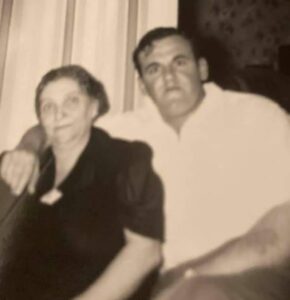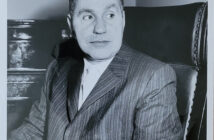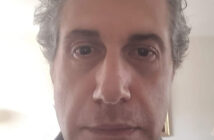Addendum Six will cover a number of questions and comments concerning the ongoing Mafia Report series. Most, if not all of the comments or questions came in through private communications.
Some recent questions and comments seem to be focused on how my late Uncle Romie Nappi and my late father, Armando Fosco, were able to keep their partnership in Chicago Outfit endeavors under the radar during their existence in Outfit rackets from the late 1930s to the middle 1990s. I’d be glad to explain this in more detail.
As early as the 1930s, my father and one of his older brothers, Benny, were known to be tough kids from the Taylor Street area (Chicago’s Little Italy). Sometime in the late 1930s my father and (step) maternal uncle Romie, were introduced to each other through my now late paternal Uncle Benny. These fellows were all older teenagers at the time. Romie was quickly impressed with how tough Benny and Armando were. You see, Benny and Armando came from a family of four brothers in total. None of the Fosco brothers were extensively educated. They struggled with anger problems relating to the premature death of their father, Michael, who suddenly passed away in an automobile accident in 1929. The Foscos fell on hard times after the death of their father.
In my father’s household growing up (after his father’s death), when normal everyday arguments broke out among the Fosco brothers, these conflicts were almost always settled through fist-fighting, and sometimes worse. One brother once shot (with a real gun) the other brother during a fight, leaving a serious flesh wound. These experiences gave my father the opportunity to develop fighting skills at an early age.
Once, when my father was 14 years old, he noticed his oldest brother counting a great deal of cash in his bedroom. My father asked him for some of his money. His brother reached into his pocket and pulled out a genuine handgun, as he began handing the gun to my father, he said, “Take this gun, you can have it. Now go out and get all of the money that you want. And remember, when I started out, I didn’t even have a gun. I had to get a gun before I could get the money.”
Not too long after my then 14-year old father received his new gun from his older brother, he was out in the community with his girlfriend at the time, as well as with another romantic couple. The four teens were partaking in a night out together in Chicago’s Sheridan Park near Polk and May streets. While in the park, as young kids sometimes do, my father decided to show off his gun to the others. The other boy’s girlfriend immediately became frightened, understandably feeling threatened by the mere sight of my father’s gun. The scared girl let out a loud panicked scream, then shouted “he has a gun!”
Someone nearby instantly reported this matter to Chicago’s Maxwell Police Station. Four Chicago police officers quickly caught up to my father’s location. As my father was confronted by the four police officers, my then 14-year old father drew his weapon. Fortunately only a mere scuffle broke out between him and the police. He was extremely blessed to have only sustained a jaw fracture.
For those who are aware of my father’s large jaw, now you know the reason for its unusual size. His jaw wasn’t correctly set after the fracture, so it never healed properly.
If it weren’t for his obvious youth, he would have probably been shot and killed instantly by the police, who would have most certainly been justified for shooting him, as he was armed with a gun. Obviously, the police showed my then young father mercy, which I am very grateful for.
Ironically, I would later discover that a young man who I grew up with happened to be the grandson of Officer Anthony Trifone, one of the four police officers who arrested my father that evening. I am further aware that Officer Trifone was somewhat helpful to my father by making sure that a broken jaw was the only serious injury that my father sustained that night. As a point of interest, Officer Trifone was the only policeman of the four who was of Italian descent. Perhaps the common heritage between my father and Officer Trifone was the reason he was somewhat helpful to my father.
The domestic violence among the Fosco brothers quickly made its way into the community. Soon those who were not their relatives became punching bags for the Fosco brothers. It was this kind of activity on the streets of Chicago in the Taylor Street area in the 1920s and 30s that ended up catching the eye of a fairly young Romie Nappi, who was not a physically tough person. In fact, Romie was often seen as meek and mild-mannered by those around him. Romie was a kind gentleman during his entire adult life. Despite Romie’s polar opposite appearance and personality from quintessential Outfit thugs, he was already well on his way at a young age to serious places in the Chicago Outfit, thanks to his maternal uncle, Tony Iorii.

Armando Fosco with his mother-in-law, Assunta Iorii Nappi in 1950, during the height of the era when Armando was a tremendous asset to the Chicago Outfit for his physical talents.
Tony Iorri was a high-ranking Outfit member, tightly connected to Al Capone, Paul Ricca, and some of their other infamous allies, like Jake Guzik and Murray “The Hump” Humphreys. While avid readers will already know something about Tony Iorii, I want to briefly point out how important this man was to Al Capone. While Capone was friends with Tony, the fact he was given a territory spanning from just north of Chicago to roughly the Milwaukee area meant that Al saw something very serious in Tony. An example of something much different could be found in the territory Al gave to another close friend of his, Louis Thomas Fratto. Al liked Louis as a friend, however, in terms of Louis’ seriousness, Al literally put him out to pasture by giving him a territory in Des Moines, Iowa. Aside from the possibility of making moonshine until the end of Prohibition in 1933, what was Louis doing in Des Moines? Trying to start a corn croppers union? Booking hog races? Pimping farm animals?
When my father’s professional alliance and friendship with Romie began in the late 1930s, their primary business usually consisted of Romie hiring my father to beat up certain people for $25.00 a pop (literally). It was not until around late 1941 through early 1942 that my father became a more viable and identifiable component among Tony Iorii’s immediate crime faction (several names of these affiliates can be found in the initial portion of this report). A premature and unexpected death of Romie’s oldest brother Ralph Nappi caused Romie’s elevation in the Outfit a little earlier than planned by the higher-ups. Ralph’s sudden death was also the reason that my father was pulled a little further into the picture. This was also the time that my father married Romie’s youngest sister, Gloria (God rest my lovely stepmother’s soul).
Prior to my father’s friendship with Romie commencing in the late 1930s, the closest my father had ever experienced in having any kind of interaction whatsoever with a real Chicago Outfit member is when he was around 8 and 9-years of age. My father, along with other slightly older relatives and friends (all who were children around the same time), would sometimes gather by their friend Nello’s father’s place of business, Spino’s Italian Restaurant, which was located in Chicago’s Little Italy neighborhood, near the 900 West block of Polk Street. The kids would sometimes gather around when they were nearby the restaurant during times that a previously named infamous customer would arrive. This person was no other than Al Capone.
The kids would seemingly feel a sense of excitement while watching Al Capone climb from his car to enter the restaurant from time to time. Al enjoyed dining at Spino’s, as well as he enjoyed dining at several other local establishments. Often, Al would wave to the kids and sometimes give them a few bucks. The restaurateur’s son, Nello, would usually be among this group of child-spectators. These kids really enjoyed their experiences of seeing Al Capone, which were obviously very innocent experiences for them, considering the nature of the incidents.
During the days of my father’s childhood, where he sometimes saw Al Capone drive around in the Little Italy neighborhood of Chicago, my father probably never fathomed that one day, not too far off, he would be in cahoots with some of Al’s closest criminal allies.
Upon Romie’s elevation within the Chicago Outfit, he was quickly brought into their political and labor rackets section, as well as other rackets involving gaming. However, the political and labor rackets were Romie’s most important responsibilities for the Outfit. Jake Guzik, who by this time was serving the Chicago Outfit as their chief bagman for payoffs to police and politicians, began working with Romie for the purpose of teaching Romie the ropes. Murray “The Hump” Humphreys by and large worked jointly with Jake Guzik, and by then with Romie, on political racketeering matters. However, Murray handled labor rackets too. Murray began teaching Romie the ropes on the labor front, as well as the other fronts.
Very soon after Romie’s collaboration with Jake and Murray, my father started working with Jake and Murray as well. However, my father’s role was somewhat different. While Romie went about town rubbing elbows with business titans, major Outfit bosses, and powerful politicos, my father was kept in the same gruesome role Romie initially recruited him for. Armando would be sent to visit particular people for Romie, Jake, and Murray, sometimes taking drastic measures – in a physical sense – to persuade others to do things that they were initially reluctant to do.
While my dad was not the only person to serve the Outfit in such a role, most enforcers never became as connected as Armando. He was unique in the sense that he was close to men like Romie, Jake, Murray, and North Side boss Ross Prio. My father became very close with Prio, who was in charge of the North Side of Chicago for many years, turf that was originally tied in very closely with Tony Iorii’s territory (click here to see supporting documentation). In addition to Prio’s stronghold on Chicago’s North Side, he was also enormously powerful with the Chicago Outfit’s Chicago Heights crew, which also made my father very influential within the Chicago Heights crew.
Out of all of the iconic Outfit mentors that my father had grooming him at different times and for various reasons during the early years of his career with the Chicago Outfit, one of his top three favorites was Murray. Murray and Jake usually referred to Romie as Jack Knapp, and my father as Tony Cozzi, which was clearly one of their ways of keeping Romie and my father very discreetly involved in certain matters (click here to review some supporting documentation from the voluminous batch of JFK Assassination records that were released by the U.S. Government in recent years). Murray often taught those around him, especially my father (and Romie) how important it was to keep a very low profile. Unfortunately, others like Sam Giancana and Jack Cerone obviously didn’t grasp this lesson too well. In fact, Murray, Romie, and my father bonded so well, that one year when Murray happened to score a number of Piaget watches, that he ended up giving away to several important Outfit operatives, whom he appreciated very much, my father and Romie were certainly among those who received watches. While over the years some of the other illustrious Outfit members gave Romie and my father comparable stature gifts, this particular watch stands out for another reason.
In the 1970s, my father was spending some time with one of his good friends, the now late George Salerno, who was a prominent funeral home proprietor. George was particularly enamored of my father’s nice Piaget, and he repeatedly complimented my father’s taste. After the second or third compliment, my father took the Piaget off his wrist and gave it to his dear friend George as a gift.
If the Salerno family still has this watch and wishes to sell it so it can be returned back to my family, please contact me. One of my brothers may be interested in buying it. Unfortunately, the watch is probably most likely impossible to locate by this time. It never hurts to ask, though. Thanks to photos and other close sources, I can give a detailed description of the watch should the family contact me to verify my family’s connection to the watch.
I wanted to tell this story to illustrate that, despite knowing full well what Armando did for the Chicago Outfit, I do see my father as more than a member of organized crime. He liked to treat his friends well, and he had a sense of pride in his neighborhood that extended beyond his illicit activities. For instance, in the summer of 1941, my father volunteered as a carpenter to help redevelop a 44-acre country estate located 6-miles South of Chicago Heights. The project was a dream come true for Chicago’s Little Italy neighborhood’s then West Side Community Committee and Our Lady of Pompeii Church. At the time, the country-estate was being converted into a camp that was largely intended to accommodate troubled children from Chicago’s Little Italy neighborhood (click here to review supporting documentation). These kids were considered dead-end kids, which is a way of describing kids that appear to lack signs of a promising future. As a teenager, my father was regarded by some as a dead-end kid. Perhaps that is why my dad looked out for dead-end kids, which is something he did for the rest of his life.
The Mafia Report Series:
5/13/20 – Mafia Report: Chicago Outfit
5/31/20 – Mafia Report: Chicago Outfit – Addendum One
6/4/20 – Mafia Report: Chicago Outfit – Addendum Two
6/24/20 – Mafia Report: Chicago Outfit – Addendum Three



